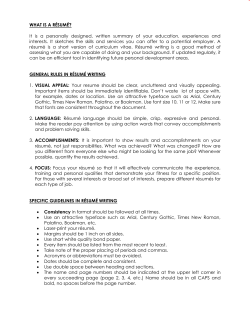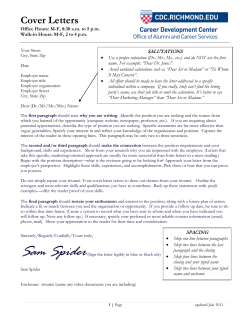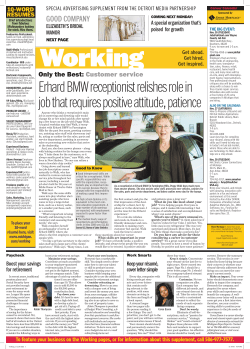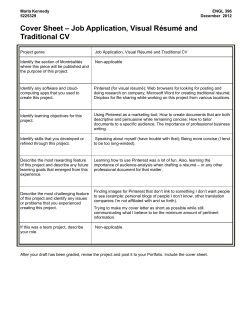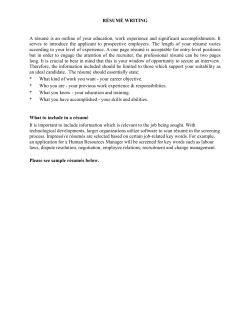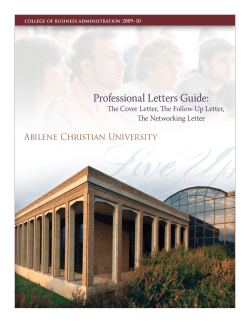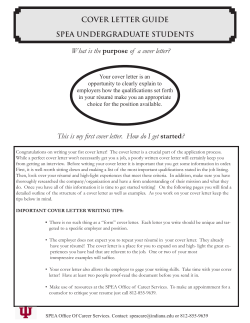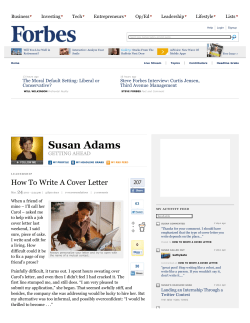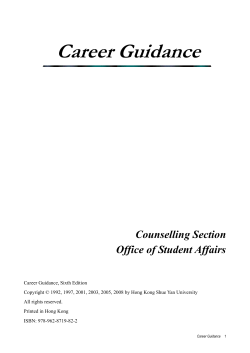
Résumés and cover letters
Dept of English & Journalism Résumés & cover letters 1 Résumés and cover letters Bradley Dilger <cb-dilger@wiu.edu> Department of English & Journalism, Western Illinois University The résumé and cover letter are standard tools for applying for jobs. The resume has three goals: 1) provide basic contact information 2) describe your relevant education, work experience, and professional history 3) provide contact information for references The résumé usually makes a job objective clear, either by explicit statement or through its focus. It focuses on work and internship experience and relevant skills. The cover letter compliments the résumé, highlighting accomplishments which fit a specific job description, emphasizing your best work, and concluding with a call to action. The résumé We recommend one of three methods for building a résumé: 1) Use the worksheets included in this handout. 2) Follow the method suggested by WIU Career Services at their website http://www.wiu.edu/student_services/careers/ – for example: a) If you don’t have a specific job, internship, or graduate program in mind, think about the kinds of positions or programs you are interested in as you develop research interests or career objectives. b) Think about any experience, training, or skills you have that are relevant to the position or program to which you are applying or which you are interested in pursuing. c) Target your résumé as much as possible to increase your marketability. d) Write your résumé with readers’ points of view in mind. What would they be most interested in knowing about you? What would make you stand out as best suited for the position or program? e) Strike a balance between clear, sufficient detail and conciseness; highlight your accomplishments but don’t brag. 3) Make a reverse-chronological list of everything you’ve done possibly relevant to your professional interests. Familiarize yourself with the categories typically used in résumés (see below). Then fit the items on your list to categories, considering our advice on categories below. What should or should not be included in the résumé? Most résumés begin with objectives or career goals. Your résumé should include any items relevant to your academic discipline and your current professional work. Things which are not relevant shouldn’t be added; being brief is preferable to padding. Since part of the job of these documents is providing a professional history, you should always list your degrees, even if they are not in English. Additionally, you should also include information which explains a gap in your chronology. For example, if you worked a year between undergraduate and graduate work, include a brief entry which explains that. Don’t include high school or part-time educational experience unless there is something meritorious about it—for example, if you achieved a special certification or took classes relevant to your discipline—or if you have little else to offer. More things to consider: • Use sections, and pick them wisely. Sections make your résumé easier to read. Adjust the sections you pick, and their order of presentation, to meet your strengths. For example, if you have many awards and scholarships, but little job experience, begin with awards. Also, omit any sections that you Dept of English & Journalism • • • Résumés & cover letters 2 don’t need. You can also label or combine sections to highlight specific experience or qualifications you have which meet a specific need in the job description. Be brief. Don’t pad; include the minimal verbiage necessary for any item. Be consistent. Use the same order and formatting for entries of the same type. Try to format entries under different subheads in similar ways. Don’t double up. Each item or activity should be listed only once. Using your résumé as a diagnostic Keeping a résumé can help any student with professional development: as you develop these documents, you can evaluate your experience, your research, what you intend to do after you earn your degree, how you wish to market yourself, etc. Share your résumé with prospective employers, trusted professors, or advisers who can comment on areas you should improve. Do this early in your career as a student—that allows you the time to look for opportunities to build your experience, seek internships, select appropriate courses, etc. Tailoring the résumé for a specific job When you read a job description, pay close attention to each qualification the prospective employer is looking for, and tailor your résumé to those qualifications. For example, when writing your career objective, research and teaching interests, or other sections, demonstrate that you are a good fit for the position and that you have the qualifications they seek. You may even use some of the language from the job description in your résumé. Don’t copy all of it, but pick up specific words and phrases, especially technical terms, which are The more you can show you are the best candidate for the position, the stronger your application will be. Developing a cover letter The cover letter highlights your best credentials, indicates your fit for a particular position, and requests and interview or similar follow-up. In that regard, it does not repeat all the information on the résumé, but provides more depth on the most relevant points. Cover letters can also include information not readily included in a résumé, such as background information or personal history (for example if you have a history with a company, organization, or contact). Your cover letter should be one page long, formatted using the block approach. Like your résumé, it should be neat, conservative, and carefully written. To develop the cover letter: 1) Find and print position descriptions for jobs, internships, or other positions you’d like to target. Select the closest match for you—that will be the easiest to tackle first. 2) Review the position description carefully and highlight: a) required credentials or skills; b) credentials or skills which are not required but would improve your application; c) common points of interest which you share with the company or organization; d) the names of people and units of the company to which you are applying; e) specifics regarding applications—deadlines, materials requested, interview procedures, etc. 3) Perform a little research about the company or organization to increase your knowledge. If a position description includes a specific web address for more information, ensure you review that material carefully. 4) If you have any questions regarding step 2e above, make a phone call or write an email to clarify your confusion. If no contact name is provided, do a little web research and try to find a likely contact (human resources, internship coordinator, etc), or include this request in your call or email. Dept of English & Journalism Résumés & cover letters 3 5) Review a copy of your résumé and highlight matches between the position description and your credentials. Rank these matches, with the most unusual or difficult skills or credentials (specific educational points, ) taking preference over more typical expectations (punctuality, creativity, strong work ethic). 6) Considering the information you’ve gathered, select the best of the common cover letter structures noted below. 7) Draft the letter, combining your notes from steps 2-5 with the structure in step 6. 8) Print and review the letter, ensuring that it meets your needs. Make sure all requirements for application are satisfied. Ensure the letter makes clear which position you are requesting. 9) Proofread carefully, double-checking all items in 2d and 2e above—you don’t want to misspell a name or miss a deadline! Cover letter structures All letters should begin with your address, the date, and the name and/or address of the organization to which you are applying. Similarly, all letters should conclude with a call to action which requests an interview, a closing, your signature, and your typed name. 1. Focus on credentials—ideal for job a) Opening which focuses on position available b) Information about your credentials and match with the position c) Specifics about your experience and/or education 2. Focus on match of organization and your goals—ideal for job a) Opening which focuses on specific accomplishment of organization b) Match between this accomplishment and your goals c) Information about your credentials and match with the position d) Specifics about experience and education (if applicable) 3. Focus on potential—ideal for internship a) Opening which focuses on organizations’s status in the field b) Information about your credentials and match with the internship c) Experience from your courses which fits the needs of the internship d) Information about career goals and plans 4. Open with common contact—ideal for any position a) Opening which names recommender both you and organization know well b) Information about your credentials and match with the position c) Specifics about your experience and/or education 5. Open with significant achievement—ideal for any position a) Opening which names an accomplishment which makes you a match for the position b) Match between excellence of organization and your achievement c) Information about your credentials, experience, and/or education 6. Focus on education and/or research—ideal for position or internship in education a) Opening which focuses on highest degree earned b) Match between position and your educational and research achievements c) Specifics about your educational achievements (courses, etc) d) Information about career goals and plans Dept of English & Journalism Résumés & cover letters 4 Sections of a résumé Sections 1, 2, and 12 are mandatory and should appear in the order indicated. All others are optional and should be ordered according to their importance in the position description and your strengths. # Description Comments 1 Contact information This should definitely be first. Use school and home contacts if you like, listing the one you’d prefer to use first. Include address(es), email(s), and phone number(s). Always use ten digit phone numbers. 2 Career Objective If you include an objective, place it immediately below your contact information. If you don’t have a particular position in mind, spell out the type of job you want. Otherwise, demonstrate how your career objective is a good match with what the position describes. Avoid vague statements. State your immediate and long-range goals. “A statement should show that you know the type of work the company does and the type of position it needs to fill” (Beamon, qtd. in Crosby, Résumés 3). 3 Education If this is more substantial than your work experience, place it first. Begin with your most recent schooling and work backward. Generally, don’t list high school unless the school or program is unique or prestigious enough to warrant inclusion. Include schools or specialized training during military service. List names of schools, degrees earned or in progress, adviser for a thesis or dissertation, title of dissertation or thesis when appropriate, graduation honors if any, and positions held, if any. 4 Experience If your experience relates to the job you seek, list it before education. Start with your most recent job first (reverse-chronological). Provide dates and names of employers. Indicate whether the job was full-time, part-time, or seasonal. Describe your duties, indicating promotions. Include military experience. If you have no paid experience, emphasize your education (including internships and special projects). 5 Affiliations List only those relevant to the position. The names of professional organizations you’ve joined. Add the dates you joined, if you like. 6 Skills Include any relevant certifications, grant-writing, foreign languages you can speak or read, or computer or technical skills. 7 Project Experience If relevant, include a brief project description, any collaborators, and who the project was for. 8 Publications Include relevant publications, even those submitted, under review, or in other stages of production. Add any provisional status afterward, in parentheses, if applicable. If you publish both creative and scholarly work, separate this into two sections. Format publication citations in a consistent style, such as MLA or APA format. 9 Service If relevant, include names of the organizations, dates, and a brief description of your role. 10 Honors and Awards Scholarships, essay contests, etc. Include the institution and/or organization granting the award. Describe the award briefly if its significance is not apparent from the title. For monetary awards (especially grants), consider including the amount. 11 Intercollegiate Athletics List only if relevant to the position. Include the sport, position, team and institution, and an awards, recognition, or special achievement. 12 References This should definitely be last. Include full contact information, using the institutional address if possible, and the position of each reference. Dept of English & Journalism Résumés & cover letters 5 Word processor formatting Carefully developing your résumé and cover letter on the computer improves consistency and makes updating easier. Here are some things to consider: Use proper formatting for computing. One space after each period. Use paragraph spacing, not extra “return” characters. Make sure to use proper quotation marks, italics instead of underlining, and em and en dashes where appropriate. (See Robin Williams’s The PC is not a Typewriter for more details.) Use a header or footer. Like an MLA-formatted essay, it’s a good idea to include your name and page number on each page—something like “Jordan Willams, 2 of 3.” Watch page breaks. Enable “Keep with next paragraph” on headlines and subheads—that will keep a headline from falling on the bottom of a page. Turn on “orphan and widow control” to keep items from breaking across pages. Use contrasting fonts. Put your headlines and subheads into a sans-serif font such as Helvetica, Univers, or Franklin Gothic. Use a serif font such as Garamond, Palatino, Times, or Utopia for the body copy. Don’t pick anything outrageous—keep it conservative, readable, and legible. Don’t trust the screen. Always print your résumé and cover letter to proofread them. Mark any errors or changes, return to the computer, and correct them, checking off each change as you go. Avoid color, greyscale, thin lines, or graphics which may not copy well. Since your résumé and cover letter are likely to be photocopied, stick to black and white; if you use graphical elements which may not copy well, make test photocopies and adjust as needed. Watch the details. Turn off hyphenation. Make sure you use proper diacritical marks if you include any names from languages other than English. Check your spelling repeatedly. Check your contact information and that of your references. General tips Get help. Ask trusted and knowledgeable people to review your materials and make comments. You will get different answers; it’s your job to pick the ones which you think work best for you. Start the process early. Ideally, you’ll have enough time to draft generic materials or a practice run you can customize at a later date. For each application, you should also allow enough time to set aside your materials for a day or so, ensuring you proof with a fresh eye. Be conservative. Don’t use a radical design, fancy fonts, or “résumé” paper. If you know you will be sending your document electronically, this is especially important. Try emailing the document to yourself or a friend first to see how it transmits electronically. Be complete. Job duties vary; don’t just include titles, but also descriptions. Course numbers vary from school to school—include names. Generally speaking, add a brief explanation to any items which aren’t easily understood outside your local context. Look at models and examples. You can find models online at several university writing center websites, career services, and by web searching for résumé help. Textbooks available from professors or the WIU library also provide models. Ask a professor you know, your adviser, or your employer or supervisor if he or she would be willing to share his or her own résumé with you. Dept of English & Journalism Résumés & cover letters 6 Frequently asked questions Q: What style guide should I consult for questions about punctuation and similar things? A: English students should use the MLA Style Manual. Journalism students should consult the AP Stylebook. If you have a question not answered by your style manual, just be consistent. Q: Should I hire a résumé-writing service? A: No way. Do it yourself; you know your work better than anyone, and you should be making the decisions about how you are presented. But ask someone else to help you proof and polish. Q: Who should I pick to be my references? A: You need people who can and will support you enthusiastically. When you ask someone to be a reference, make sure he or she can do that. Ask if the person would be comfortable recommending you for a program or position. If you have doubts, find someone else. If you wrote an undergraduate or graduate thesis, include your thesis adviser(s). If you’ve held academic employment, include your supervisor(s). Three to five references are usual. Always double-check contact information. Name, position, and phone number should do it. Including emails can be useful, too. Q: Should I include test scores on my résumé? A: No. Employers or institutions which want them will request official reports. Q: I want to include specific information about a course I taught (or a paper I wrote, etc) in my résumé. Can’t I add this to spice things up? A: Don’t include specific information about only one or two things—you need to be consistent. This sounds like the sort of thing that would be ideal for a cover letter. Q: Can I include information about my thesis or other publications? A: Sure. Quite a few people in English or Journalism include brief summaries of publications. But “brief” is the key word here. Q: Where can I get more help? A: Ask your adviser or a professor you work with frequently to provide feedback on your materials. WIU Career Services (http://www.wiu.edu/student_services/careers/) can also help in a variety of ways; visit them in Sherman 116 or call 309-298-1838. Amy Patrick Mossman helped with many revisions of this handout.
© Copyright 2025

